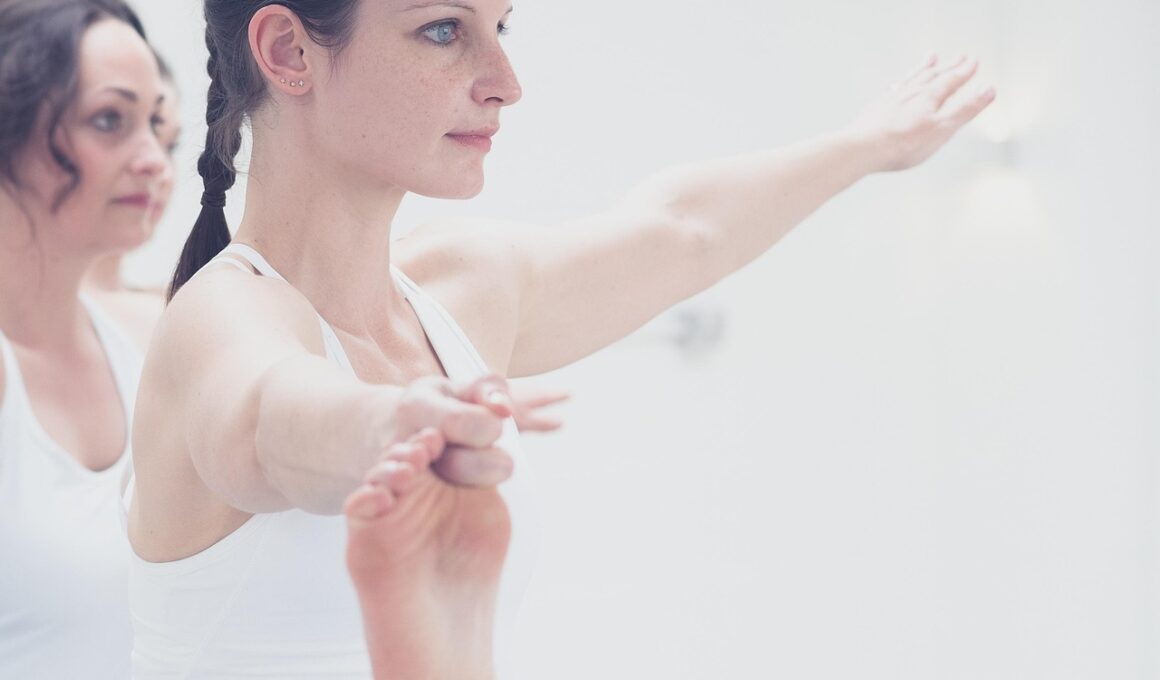Ignoring the Importance of Mobility in Overall Flexibility Development
In the journey toward enhancing flexibility, many individuals overlook one crucial factor: mobility. While flexibility often gets prominent attention, mobility works hand-in-hand with it, forming the basis for effective training. Those who focus singularly on flexibility may experience frustration later as they encounter limitations in movement. Mobility ensures that joints can move freely through their entire range without restrictions. This becomes especially critical for athletes who require complex movement patterns in their respective sports. Practicing mobility exercises improves coordination and reduces the risk of injury. Ignoring mobility can lead to muscle imbalances and functional limitations, ultimately hindering performance. To achieve holistic flexibility development, it is crucial to integrate mobility work within your training plan. Individuals should not only aim to become flexible but also mobile to facilitate complex movements. This seamless integration helps the body adapt more efficiently, allowing for greater flexibility gains while maintaining structural integrity. Incorporating dedicated mobility routines, alongside traditional stretching techniques, is an ideal approach to achieving comprehensive flexibility goals.
A common pitfall in flexibility training is neglecting to assess one’s current mobility level. Assessing mobility can reveal underlying issues that may impede flexibility. Before implementing a new flexibility program, individuals should take the time to evaluate the range of motion in key joints. This self-assessment helps identify potential areas of tightness or restriction that need attention. Common areas to evaluate include the hips, shoulders, and thoracic spine. Insights from these assessments guide targeted flexibility and mobility work. A well-rounded flexibility routine promotes balance between mobility and muscle elasticity. Moreover, integrating mobility assessments ensures individuals prioritize effective exercises tailored to their needs. Some exercises can be detrimental if they don’t cater to one’s unique restrictions or imbalances. Subsequently, incorporating corrective strategies within the flexibility training program—based on assessment findings—holds the key to sustainable progress. Ignoring these assessments can lead practitioners to focus on the wrong exercises, potentially exacerbating issues over time. Thus, regular evaluations can change the trajectory of flexibility training, enhancing overall effectiveness.
The Role of Joint Mobility in Flexibility Training
Joint mobility plays a pivotal role in flexibility and overall movement efficiency. Without sufficient joint mobility, flexibility efforts may yield minimal rewards. Tight muscles can often mask deeper restrictions in the joints themselves. For instance, mobility limitations in the hips or ankles can significantly restrict an individual’s ability to perform deep squats or complex athletic movements. When joints lack mobility, muscles compensate, leading to mechanical inefficiencies and potential injuries. Therefore, addressing joint mobility is indispensable to improving flexibility outcomes. Effective flexibility training should thus include mobility exercises such as dynamic stretches and joint circles. These exercises target the surrounding soft tissues while promoting synovial fluid distribution, essential for joint health. Enhanced joint mobility allows the nervous system to engage optimally, making two-dimensional flexibility exercises much more effective and safe. It’s crucial for practitioners to explore this synergy between joint mobility and flexibility, recognizing that both must coexist for outstanding movement quality. Investing time in mobility will yield dividends in flexibility gains, especially for athletes seeking to maximize their performance capabilities.
A frequent error is prioritizing static stretching without incorporating dynamic mobility exercises into routines. While static stretching can enhance muscle length, dynamic stretches dynamically engage muscles and joints before activity. These techniques effectively improve functional ranges of motion leading to optimal performance. Dynamic stretching can involve various movements such as leg swings, arm circles, and torso twists. Switching from static to dynamic movements helps prepare the body for the demands of physical activity. Upon warming up, the body achieves a higher level of readiness, promoting enhanced workout efficacy and injury prevention. Failing to include dynamic exercises can lead individuals to develop flexibility in a way that’s not applicable in real-life scenarios. Athletes striving for better performance may find themselves restricted by a lack of functional mobility. Therefore, integrating both static and dynamic methods into a balanced flexibility program provides a holistic approach. This diversity in training methods enhances functional movement patterns, increasing resilience against injuries. Individuals should focus on mastering dynamic stretches, creating a strong foundation for enhanced mobility and flexibility performance.
The Connection Between Flexibility and Daily Mobility
Daily activities significantly influence one’s flexibility and functionality. A sedentary lifestyle coupled with limited movement leads to stiffness over time, negatively impacting flexibility. Those who sit for prolonged periods find that their hip flexors tighten, affecting their overall range of motion, and thus limiting their flexibility. To combat this, incorporating movement throughout the day is crucial. Simple adjustments can improve daily mobility, such as desk stretches or short walks. These mini-exercises facilitate blood flow and help keep the joints lubricated to counter the adverse effects of extended immobility. Furthermore, individuals should prioritize opportunity for movement during their day, like taking stairs instead of elevators or standing while working. Engaging in physical activities like yoga or group fitness classes also promotes dynamism in one’s daily routine. These efforts lead to increased energy levels and overall flexibility improvements. By maximizing day-to-day movement, individuals pave the way for long-term flexibility gains. Daily mobility correlations can lead to sustainable outcomes, enhancing both quality of life and athletic performance.
Inflexibility in practices can result in discouragement and injuries over time. Without a structured yet adaptable flexibility program, individuals may implement overambitious goals that can lead to burnout and frustration. First and foremost, flexibility is a gradual process that takes consistency and patience. It’s essential not to rush results, as this can lead to setbacks and even injuries. Embracing a gradual approach allows the body to adapt and improve steadily. Including manageable goals and making adjustments to training schedules can prevent the pitfalls of overtraining or inconsistent routines. Additionally, varying training methods helps retain motivation and increases interest in a flexibility set. Break through periods of stagnation by introducing new exercises or modalities, such as Pilates or tai chi. These alternatives can stimulate improvement and provide fresh challenges while enhancing mobility. No one should fear minor setbacks or slow progress; instead, use them to reassess goals and refine training methods. Understanding flexibility requires time and commitment enables practitioners to cultivate a positive mindset when it comes to their flexibility journey.
Sustaining Flexibility Gains Over Time
Maintaining flexibility gains is a crucial factor in any training journey. Once individuals achieve improved flexibility, they may find it tempting to slack off. However, sustaining these gains requires dedication and a well-devised plan that encompasses both flexibility and mobility work. Returning to prior habits can lead to the loss of hard-earned progression. Consistent practice intertwined with mobility drills ensures that flexibility remains prominent. Regular monitoring of flexibility and mobility can help individuals stay accountable to their training. A commitment to daily stretching or movement routines assists in preserving and further enhancing results over time. Many effective mobility protocols can be integrated seamlessly into various training regimens. Additionally, adherence to warm-ups and cool-down routines becomes vital in creating sustained flexibility adaptations. Keep in mind that muscles must continually be challenged to foster ongoing gains. Hence, adapt stretch types with changing seasons or training priorities. This adaptive strategy guards against the common pitfalls of routine stagnation and security, ensuring steady improvement and advancement.
It’s essential to remember that ultimate flexibility development can only be achieved through comprehensive training that considers both flexibility and mobility. Adopting a balanced approach that incorporates both aspects ensures that each enhances the other for optimal results. Recognizing that mobility limitations can hinder flexibility allows for the integration of key mobility exercises into a training program. In this way, individuals can avoid the common mistakes that hinder their progress. Continue educating yourself on the importance of mobility and flexibility to make informed decisions regarding your training routines. Understanding and evaluating your own unique needs leads to better outcomes and enhanced performance. Flexibility and mobility are not mutually exclusive; rather, they work in tandem. As individuals develop their training practices, they should create a synergy between flexibility and mobility, thereby amplifying their overall movement quality. As a result, such an approach will contribute to a more functional and resilient body in the long run. Finally, continually evolving your flexibility and mobility practices will foster not only successful physical adaptations but also a deeper appreciation for movement throughout your life.


